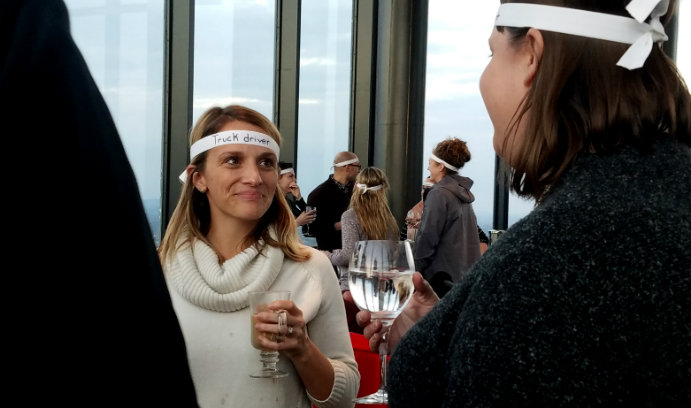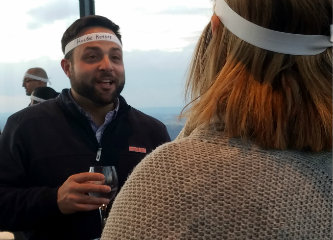Giving in to Stereotypes—and Learning a Lesson

Students wore headbands that labelled them in a variety of roles, including truck driver.
A governor, a police officer and a convicted felon walk into a cocktail party.
It might sound like the beginning of an anecdotal punch line, but rather, it’s the beginning of Floyd D. Beachum’s last class of the fall 2017 semester in his Leading Inclusive Learning Systems course.
On Thursday, Dec. 7, the masters and doctoral students enrolled in the course found themselves in the Tower Room of Iacocca Hall at 4 p.m., where Beachum, associate professor of educational leadership, told them to line up in the back of the room to receive a white headband.
Table by table, the students walked to the back of the room, sat in a chair and had the headband tied around their forehead. Circling their head like a halo, each band had an identity scrawled onto it. Not knowing what their own band read, the students were instructed to pour themselves a drink, walk to the center of the fish bowl room and mingle.
For the next 20 minutes, the headband-wearing students interacted with each other as if they were at a cocktail party, but they were instructed to treat each other according to how society would treat the person labelled on each headband.
After the last headband was distributed, the cocktail party began.
Personified Stereotypes
A janitor, salesperson, welfare recipient, nurse, drug addict, lawyer, teacher, homeless person, college president, prostitute, police officer, mechanic, undocumented immigrant, truck driver, and more wandered around the Tower Room, drink in hand, looking for conversation.
Some were shunned almost immediately.
“How many kids do you have?” someone asked the welfare recipient.
“How was work? Must be hard,” the governor said while making a face at the janitor.
“Did you just get out of rehab?” someone asked the drug addict.
As students sipped on their water and continued to meet new personas, the room inadvertently started to split into segregated groups based on perceived identity. Although students were acting in the guise of anonymous members of society, the reactions from their peers gave away varied social realms.
Joseph Pacitti, an English teacher at Salisbury High School and current doctoral candidate in school leadership at Lehigh's College of Education, said that he felt like the activity manifested hidden patterns of behavior. His headband read “house cleaner.”
“I actually felt a sense of rejection when one of my colleagues, Neiad Ammary, walked past me, ‘University President’ labelled prominently on his forehead,” Pacitti said. “He didn't even know that his position was perceived as more valuable than my own, but he carried himself as such.”
After 20 minutes of some perceptive dialogues and other uncomfortable conversations, Beachum asked students to sit down and reflect on their experience. Students discussed the major barriers to achieving the ideal of inclusion: prejudgment, cursory perception, confirmation bias, cliquish tribalism, poor attitudes and even negative body language. Many students recognized the privilege they had of even being able to “take off” their headband and step out of their identity.
“We injected live bias into this activity to recognize that bias isn’t some big scary boogey man out there,” Beachum said. “It’s within each and every one of us.
“It’s also within us, however, to change that status quo.”
Reimagining Learning at Lehigh
The activity was designed to enhance Beachum’s teachings in his Leading Inclusive Learning Systems course, which focused on how to include all categories of students in education, including students of differing socioeconomic status, race, ethnicity, gender and disability.
Although papers and presentations were still incorporated during the semester, Beachum aimed to complement traditional learning with a new type of immersive learning experience.
“You might forget something that you read in a textbook or not remember a final exam question,” he said. “I guarantee, however, that people will remember what they went through with this particular activity.”
Students agreed. Pacitti said that the learning experience—one he described as authentic, contextual, collaborative, and risky—was one of the reasons he chose to attend Lehigh.
Graduate assistant Tashina Khabbaz, who helped engineer the activity, said that she never had an academic experience such as this one. Khabbaz and Beachum both recognized the need to constantly innovate teaching practices in higher education.
“We need to get professors to not be so predictable in their teaching,” Beachum said. “I know it’s hard sometimes to step out of the box because it’s the land of unpredictability. What lies beyond, however, is innovation, creativity and new knowledge. That’s what we should pursue here at Lehigh. We should constantly be in pursuit of new knowledge.”
In fact, the headband activity was no exception to their desire to combat bias and promote inclusion. By the end of the evening, the governor and the janitor had found each other again, but this time to proudly look into each other’s eyes and firmly shake hands.
Story and photos by Nadine Elsayed
Posted on:





